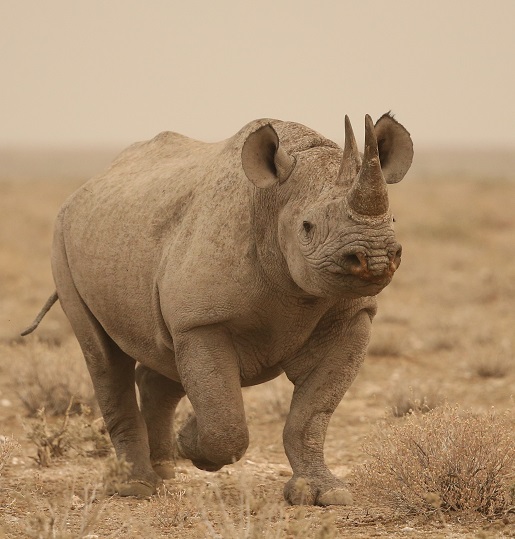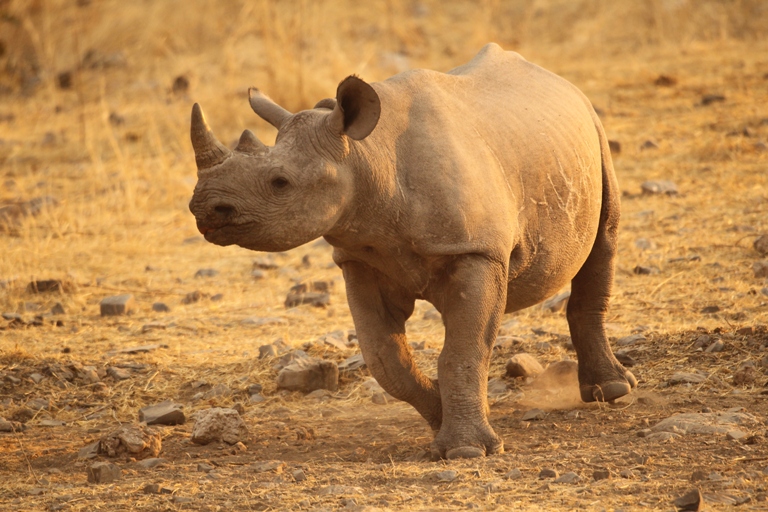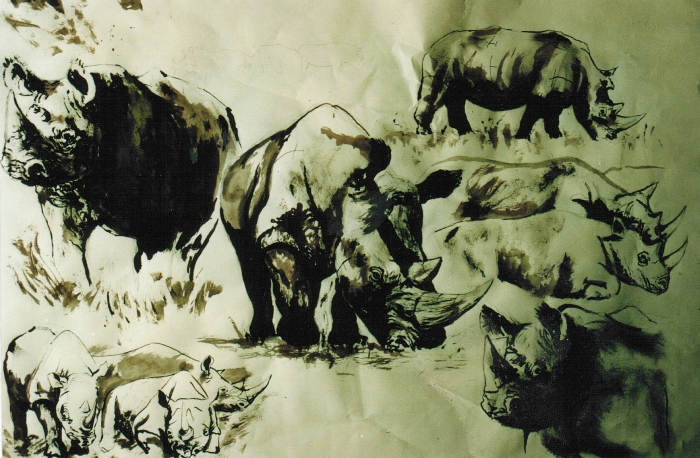AS SEEN IN





Home » Close Encounter with a Rhino Inspires New Painting
Rhinos are magnificent animals. With wrinkled, armoured-looking skin and spiked horns, they look almost prehistoric as they amble across the dry plains of Africa. Close up, they are also quite intimating, as I discovered when I travelled to Namibia to see them.

I had timed the visit to photograph black rhinos for an exhibition on endangered species taking place on my return to the UK. Little did I know that despite going to Namibia with the intention of saving rhinos, I was going to have to save myself from one!
I was traveling with a party and we were in two cars. I had driven my car into the path of this rhino, having spotted it moving across the plain. I wanted to photograph it head on. But as I clicked away taking a succession of photographic studies, the one-ton animal suddenly broke into a trot. It was heading directly for the car.
At first I was wasn’t too worried. But then the driver of the second car started up his engine and the rhino, on hearing the noise, broke from a trot into a full-on charge. It came straight towards both vehicles at full pelt and for a moment I really thought it was going to go for us. Luckily with about 20 yards to go it stopped suddenly in a cloud of dust and then held its head high in the air. As it listened and scented the air, I just on taking photographs oblivious. But afterwards I saw how frightened the others in our party were and realised how close we had come.

It was the second time I had visited Namibia’s Etosha National Park, which is the best place in the world to see endangered black rhino. Tragically black rhinos have been hunted to near extinction for their horn which is used as a component of Chinese medicine. But in Etosha they have made a comeback from just 15 individuals back in the 1960s to a growing population which at the last count more than 1,000 black rhinos, all in an area only slightly larger than Yorkshire.
On my previous visit to this park, in 2010, it was the dry season and you could see rhino drinking at the water holes. It is rare to see black rhino during the heat of the day, although I did manage to see one on one occasion browsing on leaves and bushes. But at night, just as dusk fell, they would come to drink.
It was incredible when, out of the gloom, the rhinos would appear. They are solitary animals but one night I saw up to eight individuals at once. This was more than I had ever seen. As the rhinos appeared they would greet each other with grunts and growls. Some were obviously rivals and approached each other with great caution.
If neither gave way, they would duel with their horns – which to poachers are worth more than their weight in gold. Surprisingly for a creature of their stature, they were wary of elephants and would often linger in the shadows until the herd had left. If the younger elephants spotted them they enjoyed chasing and tormenting them, which made for great viewing.

In the past, I have raised over £1,000 for Save the Rhino and after that visit I had arrived home feeling very positive about their future. But that very night on the 10 o’clock news it was revealed that rhinos are facing an entirely new threat. A new breed of rhino poacher has developed. National Parks are no longer dealing with people with crude snares made from fencing wire. Poaching rhinos is now organised by criminal gangs, who are armed and equipped like soldiers.
Modern day poachers track rhinos on foot with GPS systems and night vision equipment for days. Once, the positions have been certified a second team fly into the park on helicopters to dart them with tranquilisers. The criminals land and saw the horns off with a chainsaw, before flying off with the horn and leaving the creature to slowly bleed to death.
Rhinos in neighbouring South Africa have been hit hard. According to Save the Rhino, a rhino is slaughtered every 16 hours (*2023 data). And in spite of an international ban, rhino horns continue to be sold to the two main markets of the Middle East and the Far East.
Increasingly strong trade links between Africa and the Far East has further facilitated the supply chain, making it shorter and less risky. Conservationists are at a loss over how to respond. But one thing is for sure, we have brought them back from extinction once, and we must not allow for the risk of a repeat of the same situation again.

None found
Sign up to my newsletter for updates on news, wildlife sightings, products and more directly to your inbox
AS SEEN IN





THE ROBERT FULLER GALLERY
FOTHERDALE FARM
THIXENDALE, MALTON
YO17 9LS
UNITED KINGDOM
TEL: +44 (0) 1759 368355
EMAIL: mail@robertefuller.com